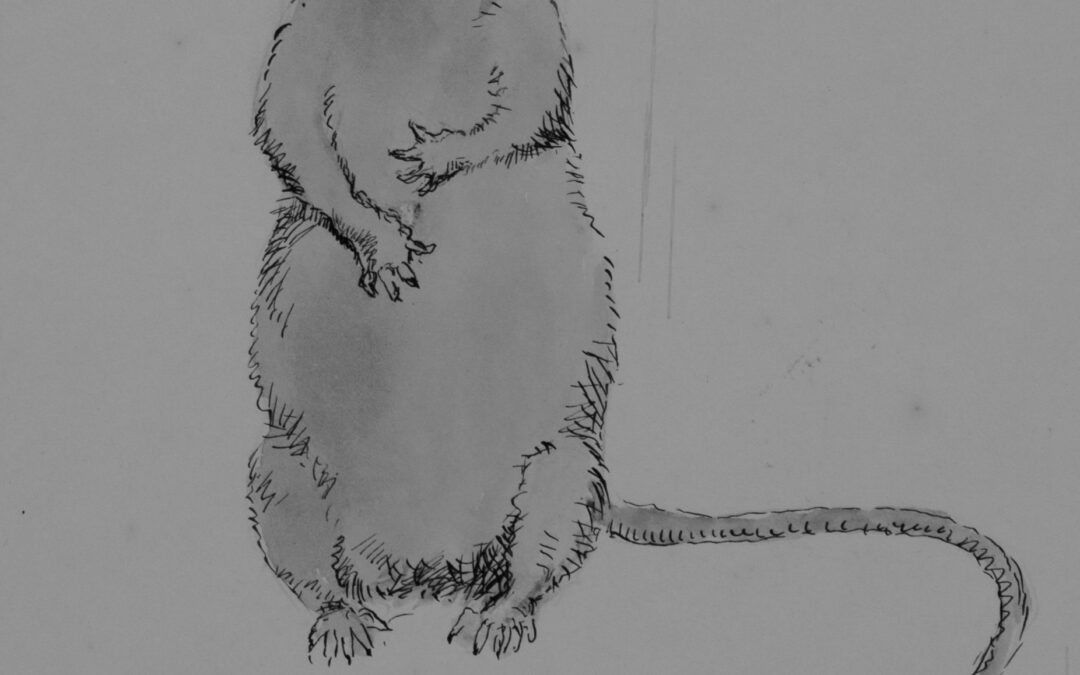The Singing Mouse, drawing by Ernest Thompson Seton, Academy for the Love of Learning
Deer mice and house mice take turns trying to invade my house. This ends badly for them (dispatching traps, never poison) but to give them their due, they keep trying. Seton wrote less about mice than other mammals, although he found their vocalizations worthy of note. I have collected a few of his mouse observations from Life Histories of Northern Animals (1909).
Grasshopper-mouse, Onychomys leucogaster
“This species seems unusually gifted, for its family, in the matter of voice. In my Yellowstone journal I find this note for June 28, 1897: ‘Yancy’s, Yellowstone Park. Today as I was sitting on an open sandy bank near the Yellowstone [River], I heard a prolonged, plaintive, squeaking call, repeated at intervals of four or five seconds.
‘It seemed to come from a part of this bank, about thirty feet from where I sat. The calling ceased when I went to the place, but I found the bank honeycombed with mouse-holes of microtine style, and of about two-inch calibre. All about was open, sparsely grassed country. The sound was like that of a Calling-hare, but much higher pitched, and there was no Calling-hare ground within many miles; it certainly came from these holes. I have not yet found the cause of this crying, but doubtless it is the unknown habit of a well-known creature.’
The answer to my riddle I found in V[eron] Bailey’s notes on a Grasshopper-mouse that he kept in captivity. [Quoting Bailey]: ‘He settled one thing for me: that a squeaking cry which I heard at evenings at Brown’s Valley and once or twice at Duck Lake was made by this species. He has made the same sound several times. It is something like the cry of the Flying-squirrel.’” (Pg. 486)
Artic Deermouse, Peromyscus maniculatus articus
“This beautiful little creature is an expert climber, and its ideal nesting site is in some hollow log or tree well up from the ground. In the woods this means usually a woodpecker hold or some hollow heart that is reached only by a very small opening.
I once found one in a deserted wren’s nest in a stump. Around buildings it will use any kind of cranny, high or low, and will often make a nest in some movable box or bundle within a few hours after it has been set down. The nest itself is an ambitious structure from three to eight inches in diameter. Globular, completely roofed in, and entered by a self-closing doorway on one side. It is composed of straw, bark, and various native cottony plants, and is very warm, and, like everything about this dainty little animal, shows a keen appreciation of the creature comforts of life.
This elaborate construction is amply justified by the facts that the nest is not a mere nursery. It is the home of the family the whole year round, and must be proof against rain, frost, and flood, as well as hidden from innumerable enemies.” (Pg. 495-496)
Vole, Genus Microtus
“About 70 North American species and races of the genus Microtus appear on the latest lists. Their minute differences, individual variations, and endless intergradations, are a puzzle to most naturalists. It is impossible to identify them without elaborate study of many specimens—skull and skins. One can only hope and believe that this present repellent multiplication of names will give place to a simplified comprehensible system that shall be a help to the study of the animal itself.
I feel something like desperation when endeavoring to identify any of the genus by a book or even by labelled specimens. Especially when I seek as heretofore to be guided y external characters. They prove most unreliable. Fortunately, there is another means, the safest of all, the characters presented by the teeth; and in this department the Meadow-mice are most happily placed.
They may be coarse-furred, coarse feeders, with coarse, blunt muzzles, but they are possessed of the most exquisite little carved ivories in the way of molars that any of our creatures can boast. The teeth of white enameled lines and curves in high relief are inlaid with brown dentine intaglio constituting at once a thing of beauty to please the naturalist’s eye, a graven record of the animal’s development, and the safest of all labels.” (Pg. 517)
(All image rights to Seton artwork reserved by the Academy for the Love of Learning.)

